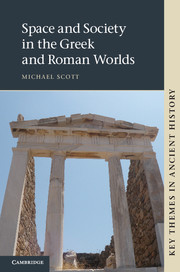Book contents
- Frontmatter
- Contents
- Illustrations
- Acknowledgements
- Abbreviations
- Introduction
- Chapter 1 Inheriting and articulating a community
- Chapter 2 Networks of polytheism: spaces for the gods at Delos
- Chapter 3 Spaces of alienation: street-lining Roman cemeteries
- Chapter 4 A spatial approach to relationships between colony and metropolis
- Chapter 5 The place of Greece in the oikoumene of Strabo’s Geography
- Conclusion: space and society in the Greek and Roman worlds
- Bibliographic essay
- Bibliography
- Index
- References
Chapter 1 - Inheriting and articulating a community
the agora at Cyrene
Published online by Cambridge University Press: 05 December 2012
- Frontmatter
- Contents
- Illustrations
- Acknowledgements
- Abbreviations
- Introduction
- Chapter 1 Inheriting and articulating a community
- Chapter 2 Networks of polytheism: spaces for the gods at Delos
- Chapter 3 Spaces of alienation: street-lining Roman cemeteries
- Chapter 4 A spatial approach to relationships between colony and metropolis
- Chapter 5 The place of Greece in the oikoumene of Strabo’s Geography
- Conclusion: space and society in the Greek and Roman worlds
- Bibliographic essay
- Bibliography
- Index
- References
Summary
Introduction
In a recent Companion to Ancient History (Erskine 2009), little mention is made of Cyrene. Such absence is not unusual: the volume on Greeks beyond the Aegean (Karageorghis 2002), for example, contains nothing on Cyrene at all. But where it is mentioned most in Erskine (2009) is instructive: not in the chapter on North Africa, but in the chapter on concepts of citizenship. A quick look through the surviving ancient literature and modern scholarship on Cyrene shows an overwhelming interest in the story of its foundation, the celebration of its ruling kings, the arrangement of its later democratic constitution and the intrigue of its political place and stance within the Hellenistic and Roman worlds. Running through all these approaches is a common thread: that Cyrene is, from the standpoint of the literary sources, most often a creation of other writers, times and places.
There has also been a significant amount of work conducted on the physical remains of Cyrene. Many of the key parts of the city have been excavated, and, equally importantly, so have several of the major settlements in the wider region of Cyrenaica (cf. Figure 1.1). That material has been published in a series of excavation reports. Yet the excavations and publications are still far from complete, and some of the finds have been extremely difficult to date. Moreover, where particular spaces have been well excavated, such as the city’s agora (cf. Figure 1.9), the tendency in the resulting publications has been to split up different sides of the agora into individual volumes, the maps of which show only the particular structures under consideration rather than the agora as a whole. This is coupled with a primary focus on the borders of the agora rather than its centre, and with a decision to concentrate on finding architectural parallels for the structures from around the Greek world rather than thinking about how those structures related to others immediately surrounding them.
- Type
- Chapter
- Information
- Space and Society in the Greek and Roman Worlds , pp. 14 - 44Publisher: Cambridge University PressPrint publication year: 2012



